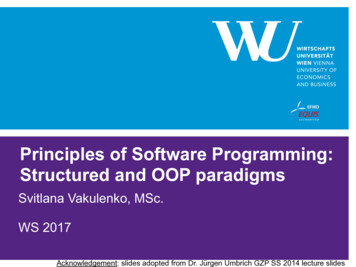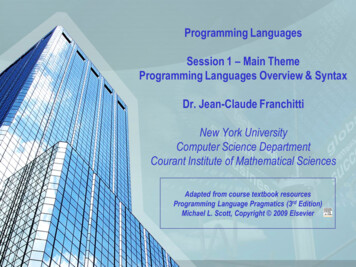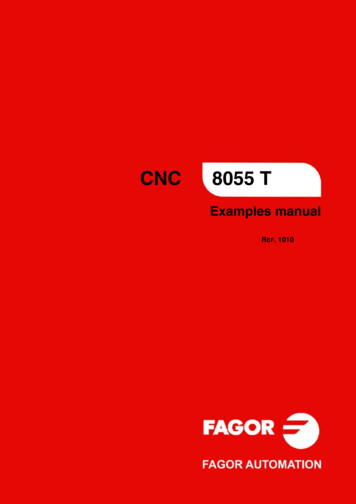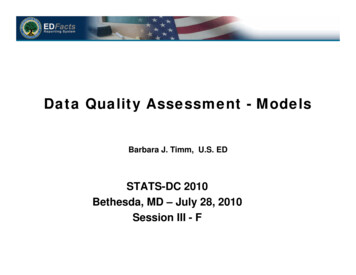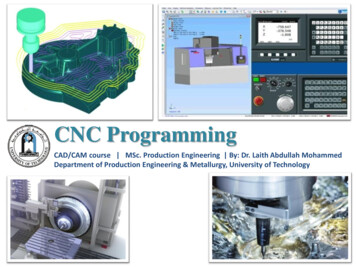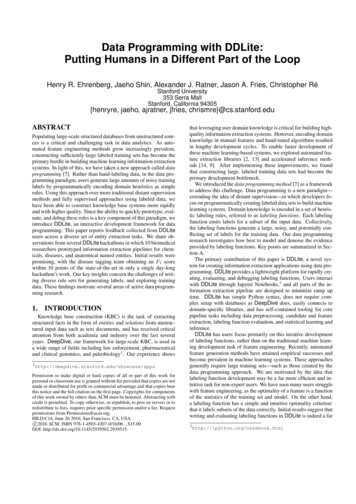
Transcription
Data Programming with DDLite:Putting Humans in a Different Part of the LoopHenry R. Ehrenberg, Jaeho Shin, Alexander J. Ratner, Jason A. Fries, Christopher RéStanford University353 Serra MallStanford, California 94305{henryre, jaeho, ajratner, jfries, chrismre}@cs.stanford.eduABSTRACTPopulating large-scale structured databases from unstructured sources is a critical and challenging task in data analytics. As automated feature engineering methods grow increasingly prevalent,constructing sufficiently large labeled training sets has become theprimary hurdle in building machine learning information extractionsystems. In light of this, we have taken a new approach called dataprogramming [7]. Rather than hand-labeling data, in the data programming paradigm, users generate large amounts of noisy traininglabels by programmatically encoding domain heuristics as simplerules. Using this approach over more traditional distant supervisionmethods and fully supervised approaches using labeled data, wehave been able to construct knowledge base systems more rapidlyand with higher quality. Since the ability to quickly prototype, evaluate, and debug these rules is a key component of this paradigm, weintroduce DDLite, an interactive development framework for dataprogramming. This paper reports feedback collected from DDLiteusers across a diverse set of entity extraction tasks. We share observations from several DDLite hackathons in which 10 biomedicalresearchers prototyped information extraction pipelines for chemicals, diseases, and anatomical named entities. Initial results werepromising, with the disease tagging team obtaining an F1 scorewithin 10 points of the state-of-the-art in only a single day-longhackathon’s work. Our key insights concern the challenges of writing diverse rule sets for generating labels, and exploring trainingdata. These findings motivate several areas of active data programming research.1.INTRODUCTIONKnowledge base construction (KBC) is the task of extractingstructured facts in the form of entities and relations from unstructured input data such as text documents, and has received criticalattention from both academia and industry over the last severalyears. DeepDive, our framework for large-scale KBC, is used ina wide range of fields including law enforcement, pharmaceuticaland clinical genomics, and paleobiology1 . Our experience rmission to make digital or hard copies of all or part of this work forpersonal or classroom use is granted without fee provided that copies are notmade or distributed for profit or commercial advantage and that copies bearthis notice and the full citation on the first page. Copyrights for componentsof this work owned by others than ACM must be honored. Abstracting withcredit is permitted. To copy otherwise, or republish, to post on servers or toredistribute to lists, requires prior specific permission and/or a fee. Requestpermissions from Permissions@acm.org.HILDA’16, June 26 2016, San Francisco, CA, USAc 2016 ACM. ISBN 978-1-4503-4207-0/16/06 . 15.00DOI: http://dx.doi.org/10.1145/2939502.2939515.that leveraging user domain knowledge is critical for building highquality information extraction systems. However, encoding domainknowledge in manual features and hand-tuned algorithms resultedin lengthy development cycles. To enable faster development ofthese machine learning-based systems, we explored automated feature extraction libraries [2, 13] and accelerated inference methods [14, 9]. After implementing these improvements, we foundthat constructing large, labeled training data sets had become theprimary development bottleneck.We introduced the data programming method [7] as a frameworkto address this challenge. Data programming is a new paradigm—extending the idea of distant supervision—in which developers focus on programmatically creating labeled data sets to build machinelearning systems. Domain knowledge is encoded in a set of heuristic labeling rules, referred to as labeling functions. Each labelingfunction emits labels for a subset of the input data. Collectively,the labeling functions generate a large, noisy, and potentially conflicting set of labels for the training data. Our data programmingresearch investigates how best to model and denoise the evidenceprovided by labeling functions. Key points are summarized in Section A.The primary contribution of this paper is DDLite, a novel system for creating information extraction applications using data programming. DDLite provides a lightweight platform for rapidly creating, evaluating, and debugging labeling functions. Users interactwith DDLite through Jupyter Notebooks,2 and all parts of the information extraction pipeline are designed to minimize ramp uptime. DDLite has simple Python syntax, does not require complex setup with databases as DeepDive does, easily connects todomain-specific libraries, and has self-contained tooling for corepipeline tasks including data preprocessing, candidate and featureextraction, labeling function evaluation, and statistical learning andinference.DDLite has users focus primarily on this iterative developmentof labeling functions, rather than on the traditional machine learning development task of feature engineering. Recently, automatedfeature generation methods have attained empirical successes andbecome prevalent in machine learning systems. These approachesgenerally require large training sets—such as those created by thedata programming approach. We are motivated by the idea thatlabeling function development may be a far more efficient and intuitive task for non-expert users. We have seen many users strugglewith feature engineering, as the optimality of a feature is a functionof the statistics of the training set and model. On the other hand,a labeling function has a simple and intuitive optimality criterion:that it labels subsets of the data correctly. Initial results suggest thatwriting and evaluating labeling functions in DDLite is indeed a far2http://ipython.org/notebook.html
Labeling Function Development Loop(a) Labeled ground truth for development(b) Labeling functions written in Python(c) Metrics for labeling functionsDevelopertfoS-ahA yb detaerCtcejorP nuoN eht morfCreate / Edit LFsLabel Development SetExtract CandidatesInput DocumentsGenerate Training SetExtract FeaturesCandidate MentionsEvaluate LFsTrain & PredictStatistical ModelCreated by Maximilian Beckerfrom the Noun ProjectnoEvaluate ResultsCandidate Mentionswith ProbabilitiesRepeat LF DevelopmentSatisfactory?yes!Success!Move to Next TaskFigure 1: DDLite users rapidly prototype information extraction systems using the data programming method. The workflow isfocused on labeling function iteration, in which the user creates, revises, and debugs rules in response to feedback from DDLite. Theentire pipeline covers data preprocessing, candidate extraction, labeling function iteration, and learning and evaluation.easier and faster process for users.Data programming and DDLite address a core challenge in creating machine learning systems: obtaining large collections of labeled data is difficult for most real-world domains. Crowdsourcingis a popular, general method for collecting large volumes of trainingdata with reasonable quality at relatively low cost. However, manytasks involving technical data require domain expertise, and thus,cannot be crowdsourced. Professional readers and domain expertsoften collect, or curate labeled data to build scientific knowledgebases, such as PharmGKB [12], MeSH [8], PubTator[11], and PaleoBioDB [1]. This approach yields highly accurate data, but suffers from scalability and cost constraints. Users of DDLite and thedata programming method devote effort to writing labeling functions that can generate new labels from more data, rather than labeling subsets of data directly for training purposes. DDLite buildson the guided data exploration techniques of machine teaching systems [10] by enabling users to directly encode domain expertiseas labeling functions rather than labeled examples and engineeredfeatures. The data programming approach also allows for instantaneous performance feedback as users rapidly iterate on labeling functions, whereas more feature engineering-based approachescannot evaluate performance without training a model.We built DDLite to address new challenges arising from incorporating human supervision in a different part of the developmentloop. Some challenges were easy to anticipate and we engineeredDDLite features to address them before shipping it out to users.For instance, characterization of the labeling functions, such as accuracy and coverage, as well as easy data exploration methods arevital for users to understand when to debug, revise, or add newrules. However, it is not readily clear which other performance representations or exploration methods would help users make moreconcrete and informed decisions. DDLite is a rapidly evolving system, and we rely heavily on direct user feedback to address thesechallenges and motivate development.In the following sections, we describe data programming withDDLite for rapid information extraction. We report our experienceand observations from a biomedical hackathon using DDLite to tryto achieve benchmark performance. We then conclude by raisinga few technical questions we believe are important for accelerating human-in-the-loop machine learning system development under our proposed data programming paradigm.2.DDLITE WORKFLOW ANDHACKATHON CASE STUDYUsing DeepDive, teams of developers have built large-scale,competition-winning KBC applications, usually spending monthsbuilding and tuning these systems [3, 5, 6]. We now describethe lighter-weight process of using data programming and DDLite.Given a set of input documents, our goal is to produce a set of extracted entity or relation mentions. We do this by first heuristicallyextracting a set of candidate mentions, then learning a model using the training data to predict which of these candidates are actualmentions of the desired entity or relation type. The user followsfour core steps in this process as shown in Figure 1:1. Data Preprocessing: Given a set of input text documents, basicpreprocessing of the raw text is performed, which may includeusing domain-specific tokenizers or parsers.2. Candidate Extraction: The user defines the set of candidatementions to consider during training by matching the parsed textto dictionaries and regular expression patterns. DDLite providesa library of general candidate extraction operators.3. Labeling Function Development: Following the paradigm ofdata programming, the user develops a set of labeling functions by iterating between exploring data (and optionally handlabeling small subsets for error analysis) and analyzing labelingfunction performance.4. Learning and Evaluation: In the DDLite setup, features areautomatically generated for the candidates, and then the modelis trained using the labeling functions developed so far. The userthen analyzes system performance as measured on a separatelabeled holdout set.
Our goal in this paper is to evaluate the effectiveness of this newprocess, specifically whether it constitutes a more efficient interaction model for users. To this end, we organized a hackathonfor creating biomedical entity tagging systems for academic text,using open abstracts and full text documents from PubMed Central (PMC). The hackathon consisted of 10 participants workingin bioinformatics labs at Stanford. Several teams worked on threeseparate tagging systems, which were designed to identify all entitymentions of chemical/drug names, diseases, and human anatomicallocations (such as muscle groups or internal organs).We now describe the DDLite workflow in more detail, in thecontext of the bioinformatics hackathon:Data Preprocessing. The first step is to preprocess the rawtext, parsing it into sentences and words, and adding standard annotations such as lemmatized word forms, part-of-speech tags, anddependency path structure which provide useful signal for downstream labeling and learning tasks. Experience has shown us thatproviding an easily customizable preprocessing pipeline is important, especially when working in technical domains where standard tools often fail. In DDLite, we strike a balance by utilizinga lightweight parallelization framework which has CoreNLP3 as asimple “push-button” default, but which also allows users to swapin custom tokenizers, taggers, and parsers.E XAMPLE 1. Some teams in our hackathon—such as the disease extraction team—used the standard tools without issue. However, many had domain-specific issues with various parts of thepipeline. This was most striking in the chemical name task, wherecomplicated surface forms (e.g., “9-acetyl-1,3,7-trimethyl- pyrimidinedione") caused tokenization errors which had significant effects on system recall. This was corrected by utilizing a domainspecific tokenizer.Candidate Extraction. The next stage of the DDLite workflow is the extraction of candidate mentions of entities or relations,which our learned model will then classify as true or false. Whenthere is not a clearly defined, closed candidate set (such as the setof human genes), feedback showed that candidate extraction can bea difficult stage for users. The core goal is to strike a balance between being too precise—since end-system recall is trivially upperbounded by the recall at the candidate extraction stage—and being too broad—since this can lead to combinatorial blow-up in thenumber of candidates considered.Based on user feedback, our solution in DDLite is to provide asimple set of compositional dictionary and pattern matching-basedoperators, thus guiding users to construct simple yet expressivecandidate extractors that easily integrate domain-specific resources.For example, in our hackathon, the separate codebase ddbiolib4was used to interface with existing biomedical ontologies and buildentity dictionaries. ddbiolib utilities were then directly connectedto DDLite.E XAMPLE 2. In the disease tagging example, the phrase“prostate cancer” (Figure 1(a)) was identified as a candidate bymatching it to a user-supplied dictionary of common disease names,using DDLite’s DictionaryMatch operator. However, erroranalysis suggested that this approach was limiting recall, so theteam also tried to augment with compound noun phrases whereone of the words matched a custom word-form pattern, such ithub.com/HazyResearch/ddbiolib‘degen. ’. This identified additional compound phrases not intheir base dictionary, such as “macular degeneration”.Labeling Function Iteration. The primary focus of DDLiteis the iterative development of labeling functions. A labeling function is written as a simple Python function, which takes as inputa candidate entity or relationship mention, along with relevant local context. This includes the annotations from preprocessing forthe sentence the mention occurs in. Labeling functions can dependon external libraries—such as ddbiolib in our hackathon—and thusrepresent an extremely flexible means of encoding domain knowledge. Labeling functions can either abstain from labeling (by emitting a 0) or label the candidate as positive or negative case of anactual entity or relation mention (by emitting a -1 or 1, respectively).E XAMPLE 3. Figure 1(b) shows two labeling functions writtenby the disease tagging team:LF noun phrases andLF cancer. The first marks the candidate as positive if “cancer” is the word lemmas composing the mention, and the secondmarks it as positive if the mention is a noun phrase with at leasttwo tokens.In order to evaluate and debug labeling functions during development, and to help generate ideas for new ones, users iterativelyhand-label some subset of the data within the DDLite framework(Fig. 1(a)). We refer to the aggregate of all such hand-labels generated by the user during labeling function development as the development set. To prevent bias, we do not use this set for any endsystem evaluation. We also assume that the quantity of labeled datain the development set is far less than what would be needed for atraditional supervised learning scenario.Several key metrics are then computed to characterize the performance of labeling functions. Figure 1(c) shows DDLite plots(illustrating the performance of the entire set) and tables (detailingthe performance of individual functions), which summarize thesekey metrics: Coverage is the fraction of candidates which were labeled, eitherby any labeling function or by a specific labeling function. Empirical accuracy is the class-dependent accuracy of a givenlabeling function with respect to the development set. Empirical accuracy generalization score is computed as the absolute difference between the accuracy scores of a given labelingfunction applied to two different random splits of the development set. Conflict is the fraction of candidates that at least one labelingfunction labeled as positive and another as negative. Counterintuitively, controversial candidates are actually highly useful forlearning noise-aware models in the framework of data programming [7], and can also be used for debugging the current labelingfunction set.As opposed to engineered features, labeling functions can be evaluated during development without training the full model. DDLiteis therefore able to provide on-the-spot performance feedback asplots and tables, allowing the user to iterate more rapidly on system design and navigate the the key decision points in the data programming workflow: Improve coverage or accuracy? When users develop labelingfunctions, they can either focus on improving coverage or accuracy. If the plots show low coverage, the user should explore unlabeled training examples and write new labeling functions basedon novel observations. If labeling functions have low accuracies,or low accuracy generalization scores, this could be indicationthat labeling functions have bugs or need to be revised.
Develop labeling functions or run learning algorithm? Whencoverage, accuracy, and conflict are sufficient, users can proceedto learn a predictive model on the data. Scores are reported onthe blind test set, and the user can continue to iterate on labelingfunctions or finalize their application.E XAMPLE 4. The plots in Figure 1(c) reveal that the diseaseteam’s labeling function set has high coverage on the developmentset. The sample of labeling functions detailed in the table shows amix of rule types, with a very high-accuracy, low-coverage labelingfunction (LF cancer) and a very high-coverage, low-accuracyone (LF noun phrase). In particular, we note that althoughLF noun phrase has a low accuracy as shown in Figure 1(c),it has high coverage and accuracy generalization score, indicatingthat it may contribute meaningfully to the model.The most significant observation during the labeling function iteration phase at the hackathon was that users are naturally inclinedto write highly accurate rules, rather than ones with high coverageThe observed bias towards accuracy also stems from the challengesof crafting high-coverage rules de-novo, motivating a key area offuture work.E XAMPLE 5. The anatomy team wrote rules looking for the tokens “displacement”, “stiffness”, and “abnormality” near mentions, since these generally accompany true mentions of anatomical structures. While each of the three labeling functions had veryhigh accuracy, they abstained on more than 99.9% of the candidates. The anatomy team eventually wrote a rule simply checkingfor nouns and adjectives in the mentions. This rule had high coverage, labeling over 400 candidates in the training set with 52.8%accuracy.Learning and Evaluation. Once users are satisfied with theircurrent labeling function set as judged by coverage, conflict, andaccuracy metrics, they fit a model to the training set and its performance is automatically evaluated on the test set. Features are generated automatically in DDLite at the candidate extraction stage.Although the envisioned DDLite workflow is centered around labeling function development and not feature engineering, users canfully interact with and customize the feature set if desired.In the data programming paradigm, we first model the accuracyof each labeling function, and then train a model on the featuresusing a noise-aware loss function to take into account the inaccuracies of imperfect and potentially conflicting labeling functions.The formal guarantees that we show for this approach are outsidethe scope of this paper, but details can be found in [7]. This generaldata programming approach can handle more complex models thatincorporate logical relations between variables—such as Markovlogic network semantics, as in DeepDive—but for our initial version of DDLite we use a logistic regression-based model as userfeedback indicates that this is sufficient for rapid prototyping anditeration.The test set precision, recall, and F1 score indicate how wellthe characterization of the data provided by the labeling functionsgeneralizes as a representation over the features. These scores alsoserve as a means to discriminate between nuanced labeling functiontradeoffs. For instance, it may not be immediately obvious from theon-the-spot feedback metrics whether a user should sacrifice someaccuracy of a particular labeling function for a coverage increase.However, end system performance can guide subtle design decisions like these.Hackathon Results. Our goal in this study was to evaluate theeffectiveness of the data programming and DDLite approach, andto do this we set an extremely ambitious goal of coming close tobenchmark performance in less than a day, using no hand-labeledtraining data. We emphasize that these benchmark systems usedmanually labeled training sets, and took months or years to build.Although we fell short of state-of-the-art performance, our overallresults were very encouraging with respect to this aspect of radically increasing user interaction efficiency. Table 1 summarizesthe labeling function (LF) sets produced by the hackathon teams,where Coverage refers to to the percent of the dataset used duringthe hackathon that was labeled by at least one labeling function,and Mean accuracy refers to the mean individual labeling functionaccuracy on the test set.Table 1: Teams, Tasks, and Labeling FunctionsEntity (Team) Team size # LFs CoverageMeanaccuracyAnatomy (1)4106.8%75.0%Anatomy (2)31475.5%86.6%Diseases (1)14100%81.6%Diseases (2)21195.3%79.3%Table 2 reports scores from a data programming logistic regression model trained using the labeling functions and automaticallygenerated features. Two test sets were used for reporting, composed of colleague-annotated data (User) and independent benchmark data (NCBI Dev), neither of which were viewed during development. As a rough baseline for current disease tagging performance, we use scores reported by Dogan et al. [4] computed usingBANNER, a biomedical NER tagging system.Table 2: Disease Name Tagging natomy (1)UserDDLite0.63 0.96Anatomy (2)UserDDLite0.62 1.00Diseases (1)UserDDLite0.77 0.88Diseases (2)UserDDLite0.75 0.98Diseases (1 2)NCBI DevDDLite0.78 0.62Diseases (1 2)NCBI Dev DDL LSTM 0.76 0.69DiseasesNCBI DevBANNER0.82 0.82F10.760.770.820.850.690.720.82We note that the hackathon user-annotated scores for diseasesand anatomy tend to overestimate recall due to small test set sizes.The NCBI development set, which consists of curated gold standard data adjudicated by independent annotators, is a more representative sample of mentions and provides a better assessment oftrue recall.The first anatomy team tended to write very accurate, but lowcoverage labeling functions that returned negative labels. This resulted in poor system precision. For disease tagging, the lowerrecall scores in benchmark vs. user-annotated reflect current limitations in DDLite’s candidate extraction step.We experimented with using features generated by long shortterm memory (LSTM) recurrent neural networks trained using thelabeling function outputs, instead of the default text sequence-basedfeatures in DDLite. We observed a three point F1 score boost in thedisease application.While these initial DDLite scores fall short of the benchmarkset by manually supervised systems, they represent the collective
work of a single afternoon versus weeks or months commonly seenin DeepDive development cycles.Emily Mallory, and Raunaq Rewari for participating in our inaugural biohackathon.3.Agency (DARPA) SIMPLEX program under No. N66001-15-C-4043, the NationalWe gratefully acknowledge the support of the Defense Advanced Research ProjectsFUTURE WORK AND CONCLUSIONSData programming with DDLite is a rapidly evolving methodology, responding to advances in theoretical work and feedback fromusers like the biomedical hackathon participants. Currently, thereare three major areas of focus for DDLite development:Science Foundation (NSF) CAREER Award under No. IIS- 1353606, the Office ofNaval Research (ONR) under awards No. N000141210041 and No. N000141310129,the Sloan Research Fellowship, the Moore Foundation, Toshiba, and Intel. Any opinions, findings, and conclusions or recommendations expressed in this material arethose of the authors and do not necessarily reflect the views of DARPA, NSF, ONR, orthe U.S. government.Useful Metrics. Coverage and empirical accuracy scores provide an essential evaluation of labeling functions, and users relyheavily on these basic metrics. However, other characterizationscan be useful for developing labeling function sets. For instance,conflicts play a crucial role in denoising individually low accuracylabeling functions and improving the set of accuracy estimates [7].How best to present a depiction of conflict that leads to performanceimproving action is an open question. Writing rules to promoteconflict is unintuitive for most users, and so informative metricsmust be combined with directed development principles.Data Exploration and Rule Suggestion. After creating andreceiving feedback for an initial set of labeling functions, candidateexploration via random sampling is no longer an effective meansof rule discovery. Without support for guided data exploration,the labeling function writing task can resemble feature engineering,where the development process stagnates due to undirected effort.Observing that writing high coverage rules de-novo was especiallychallenging, we added sampling of only candidates not labeled byany rule in DDLite. We are actively developing other smart sampling techniques for efficient, guided data exploration DDLite. Forexample, exploring candidates with high conflict or low empiricalaccuracy from the current set of labeling functions is useful for improving precision. We are also investigating methods for suggesting new, high coverage rules directly, including a curated library ofexamples and token frequency-based clustering approaches.Principled Management of Labeled Data. While manydomains have gold labels which can be used for external validation, in practice most problems require users to develop their ownbenchmark datasets. Having independent annotators create labeledholdout sets is another hidden bottleneck to the overall development process. Because individual DDLite users are actively annotating during development, there is clearly value in enabling multiple users to exchange their labeled data. To address bias concerns,i.e., users writing labeling functions that are evaluated against theirown annotations, we are implementing a more principled way ofmanaging labeled data. We can maintain a record of annotationprovenance such that the evaluation metrics for labeling functionsare strictly computed from labeled candidates that are disjoint fromtheir own annotations. There is also a need for a well defined protocol when working in a collaborative environment, since labelingfunction sharing may cause overfitting or biased performance evaluations.Given the rise of automated feature extractors, we argued that human-in-the-loop training set development plays an important role increating information extraction systems. We described the DDLiteframework, reported on its initial use by 10 biomedical researchers,and identified key areas of future work from direct user feedback.Acknowledgments. A special thanks to Abhimanyu Banerjee,Alison Callahan, David Dindi, Madalina Fiterau, Jennifer Hicks,4.REFERENCES[1] The paleobiology database.http://paleobiodb.org/.[2] M. R. Anderson, D. Antenucci, V. Bittorf, M. Burgess, M. J.Cafarella, A. Kumar, F. Niu, Y. Park, C. Ré, and C. Zhang.Brainwash: A data system for feature engineering. In CIDR2013, Sixth Biennial Conference on Innovative Data SystemsResearch, Asilomar, CA, USA, January 6-9, 2013, OnlineProceedings. www.cidrdb.org, 2013.[3] G. Angeli, S. Gupta, M. Jose, C. D. Manning, C. Ré,J. Tibshirani, J. Y. Wu, S. Wu, and C. Zhang. Stanford’s 2014slot filling systems. TAC KBP, 2014.[4] R. I. Doğan and Z. Lu. An improved corpus of diseasementions in pubmed citations. In Proceedings of the 2012workshop on biomedical natural language processing, pages91–99. Association for Computational Linguistics, 2012.[5] E. K. Mallory, C. Zhang, C. Ré, and R. B. Altman.Large-scale extraction of gene interactions from full-textliterature using DeepDive. Bioinformatics, 32(1):106–113,Jan. 2015.[6] S. E. Peters, C. Zhang, M. Livny, and C. Ré. A machinereading system for assembling synthetic paleontologicaldatabases. PLoS one, 9(12):e113523, 2014.[7] A. Ratner, C. D. Sa, S. Wu, D. Selsam, and C. Ré. Dataprogramming: Creating large training sets, quickly. 2016.https://arxiv.org/abs/1605.07723.[8] F. Rogers. Medical subject headings. Bulletin of the MedicalLibrary Association, 51:114, 1963.[9] J. Shin, S. Wu, F. Wang, C. D. Sa, C. Zhang, and
primary hurdle in building machine learning information extraction systems. In light of this, we have taken a new approach called data programming [7]. Rather than hand-labeling data, in the data pro-gramming paradigm, users generate large amounts of noisy training labels by programmatically encoding domain heuristics as simple rules.





